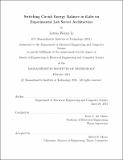Switching circuit energy balance in iLabs on experimental lab server architecture
Author(s)
Li, Letitia Weixia
DownloadFull printable version (5.762Mb)
Other Contributors
Massachusetts Institute of Technology. Department of Electrical Engineering and Computer Science.
Advisor
Jesús A. del Alamo.
Terms of use
Metadata
Show full item recordAbstract
In Electrical Engineering courses, it is important that students have hands-on experience with a circuit and components to witness their behavior and compare it with theoretical models. The MIT iLab Project develops online laboratories that allow students to perform experiments through a web browser from anywhere in the world. One such lab used in the Introduction to Circuits class, the NMOS Resistor Amplifier Lab, allows students to analyze the switching waveforms of a transistor. This thesis describes the integration of a thermal camera to the NMOS-Resistor Amplifier Lab to educate students about energy dissipation. The first version of this lab, built entirely in LabVIEW, on iLabs' existing Shared Architecture could not support an interactive lightweight client. In response, the Experimental Lab Server Architecture (ELSA) was developed as a new interface connecting an experiment, client, and Service Broker. In the first prototype of the Thermal Lab in ELSA, a Java Applet Client uses REST calls to send commands and acquire data from the LabVIEW experiment running on the server.
Description
Thesis: M. Eng., Massachusetts Institute of Technology, Department of Electrical Engineering and Computer Science, 2015. This electronic version was submitted by the student author. The certified thesis is available in the Institute Archives and Special Collections. Cataloged from student-submitted PDF version of thesis. Includes bibliographical references (pages 121-122).
Date issued
2015Department
Massachusetts Institute of Technology. Department of Electrical Engineering and Computer SciencePublisher
Massachusetts Institute of Technology
Keywords
Electrical Engineering and Computer Science.